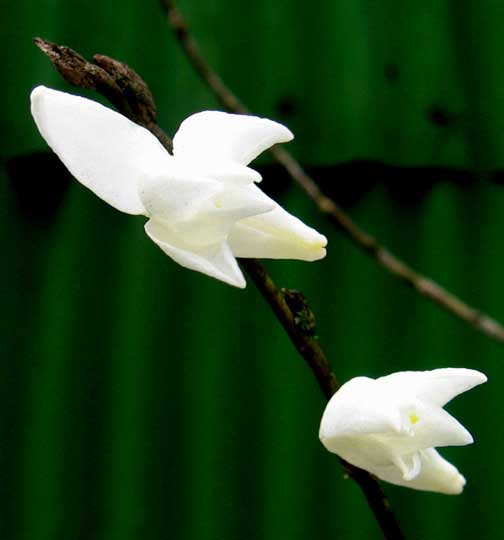
Dendrobium crumenatum (*)
Classification System: APG IV
Superregnum: Eukaryota
Regnum: Plantae
Cladus: Angiosperms
Cladus: Monocots
Ordo: Asparagales
Familia: Orchidaceae
Subfamilia: Epidendroideae
Tribus: Dendrobieae
Subtribus: Dendrobiinae
Genus: Dendrobium
Species: Dendrobium crumenatum
Name
Dendrobium crumenatum Sw., J. Bot. (Schrader) 1799(2): 237 (1800)
Synonymy
Homotypic
Onychium crumenatum (Sw.) Blume, Bijdr. Fl. Ned. Ind.: 326 (1825)
Callista crumenata (Sw.) Kuntze, Revis. Gen. Pl. 2: 654 (1891)
Aporum crumenatum (Sw.) Brieger in F.R.R.Schlechter, Die Orchideen, Beschreib. Kult. Zücht., ed. 3, 1(11-12): 671 (1981)
Heterotypic
Epidendrum matutinum Poir. in J.B.A.M.de Lamarck, Encycl., Suppl. 1: 384 (1810)
Epidendrum caninum Burm.f., Fl. Indica: 189 (1768), nom. rej.
Ceraia simplicissima Lour., Fl. Cochinch.: 518 (1790)
Epidendrum saaronicum J.Koenig in A.J.Retzius, Observ. Bot. 6: 58 (1791)
Epidendrum ceraia Raeusch., Nomencl. Bot., ed. 3: 265 (1797), nom. nud.
Dendrobium ceraia Lindl., Gen. Sp. Orchid. Pl.: 89 (1830)
Dendrobium schmidtianum Kraenzl., Bot. Tidsskr. 24: 7 (1901)
Dendrobium papilioniferum J.J.Sm., Orch. Ambon: 42 (1905)
Dendrobium simplicissimum (Lour.) Kraenzl. in H.G.A.Engler (ed.), Pflanzenr., IV, 50 II B 21: 235 (1910)
Dendrobium kwashotense Hayata, Icon. Pl. Formosan. 4: 41 (1914)
Dendrobium crumenatum var. parviflorum Ames & C.Schweinf. in O.Ames, Orchidaceae 6: 100 (1920)
Dendrobium caninum (Burm.f.) Merr., Philipp. J. Sci. 19: 344 (1921)
Aporum kwashotense (Hayata) Rauschert, Feddes Repert. 94: 440 (1983)
Aporum papilioniferum (J.J.Sm.) Rauschert, Feddes Repert. 94: 441 (1983)
Ceraia saaronica (J.Koenig) M.A.Clem. & D.L.Jones, Orchadian 13: 486 (2002)
Ceraia papilionifera (J.J.Sm.) M.A.Clem., Telopea 10: 292 (2003)
Ceraia parviflora (Ames & C.Schweinf.) M.A.Clem., Telopea 10: 292 (2003)
Distribution
Native distribution areas:
Asia-Temperate
Eastern Asia
Taiwan.
Asia-Tropical
Indian Subcontinent
India, Sri Lanka.
Indo-China
Andaman Islands, Cambodia, Laos, Myanmar, Nicobar Islands, Thailand, Vietnam.
Malesia
Borneo, Christmas Isle, Jawa, Lesser Sunda Islands, Malaya, Maluku, Philippines, Sulawesi, Sumatera.
Papuasia
New Guinea.
References: Brummitt, R.K. 2001. TDWG – World Geographical Scheme for Recording Plant Distributions, 2nd Edition
References
Primary references
Swartz, O.P. 1800. Journal für die Botanik 2: 237.
Links
Govaerts, R. et al. 2020. Dendrobium crumenatum in Kew Science Plants of the World online. The Board of Trustees of the Royal Botanic Gardens, Kew. Published online. Accessed: 2020 January 14. Reference page.
Govaerts, R. et al. 2020. Dendrobium crumenatum in World Checklist of Selected Plant Families. The Board of Trustees of the Royal Botanic Gardens, Kew. Published online. Accessed: 2020 January 14. Reference page.
International Plant Names Index. 2020. Dendrobium crumenatum. Published online. Accessed: 14 January 2020.
The Plant List 2013. Dendrobium crumenatum in The Plant List Version 1.1. Published online. Accessed: 2020 January 14.
Tropicos.org 2020. Dendrobium crumenatum. Missouri Botanical Garden. Published online. Accessed: 14 January 2020.
Vernacular names
中文: 鴿石斛
Dendrobium crumenatum, commonly called pigeon orchid,[3] or 木石斛 (mu shi hu)[4] is an epiphytic orchid in the family Orchidaceae and is native to Asia, Southeast Asia, New Guinea and Christmas Island. It has two rows on leaves along its pseudobulb and relatively large but short-lived, strongly scented white flowers. It usually grows in exposed positions in lowland rainforest and coastal scrub.
Description
Dendrobium crumenatum produces upright, sympodial, pseudobulbs 300–700 mm (10–30 in) long and 8–12 mm (0.31–0.47 in) wide that are swollen at the first three or four lower nodes. The middle portion of the pseudobulb has two rows of leathery, oblong to egg-shaped leaves 50–80 mm (2–3 in) long and 10–20 mm (0.39–0.79 in) wide. Top portion of the pseudobulb bears pure white flowers 30–40 mm (1–2 in) long and wide. The dorsal sepal and petals are 15–18 mm (0.6–0.7 in) long and 5–7 mm (0.2–0.3 in) wide, the lateral sepals slightly longer and wider. The labellum is 20–24 mm (0.8–0.9 in) long and 13–15 mm (0.5–0.6 in) wide with three lobes. The side lobes are erect and the middle lobe is rounded with five yellow ridges. Flowering is sporadic but is triggered nine days after a sudden drop in temperature of at least 5.5 °C (40 °F), usually as a result of rain, although the same effect can be artificially created. The flowers are fragrant, but the scent lasts only for one day.[3][4][5]
Taxonomy and naming
Dendrobium crumenatum was first formally described in 1799 by Olof Swartz and the description was published in Heinrich Schrader's Journal für die Botanik.[6][7] The specific epithet (crumenatum) is derived from the Latin word crumena meaning "leather moneybag".[8]
Distribution and habitat
The pigeon orchid usually grows in exposed locations, often in lowland rainforest or coastal scrub. It is found in India, Indochina, Taiwan, the Philippines, Singapore, Malaysia, Indonesia, New Guinea, and Christmas Island. It is reportedly naturalized in Fiji, Hawaii, the West Indies and the Seychelles.[2][4][9]
References
"Dendrobium crumenatum". International Plant Names Index (IPNI). Royal Botanic Gardens, Kew. 2 September 2012. Retrieved 2 September 2012.
"Dendrobium crumenatum". World Checklist of Selected Plant Families (WCSP). Royal Botanic Gardens, Kew.
Jones, David L. (2006). A complete guide to native orchids of Australia including the island territories. Frenchs Forest, N.S.W.: New Holland. p. 383. ISBN 1877069124.
"Dendrobium crumenatum". Flora of China. Retrieved 3 December 2018.
The Orchids of the Philippines, J.Cootes 2011
Swartz, Olof (1799). "Dianome Epidendri generis". Journal für die Botanik. 4: 237. Retrieved 3 December 2018.
"Dendrobium crumenatum". Retrieved 3 December 2018.
Brown, Roland Wilbur (1956). The Composition of Scientific Words. Washington, D.C.: Smithsonian Institution Press. p. 117.
Orchidiana Philippiniana vol1 Valmayor 1984
Retrieved from "http://en.wikipedia.org/"
All text is available under the terms of the GNU Free Documentation License

